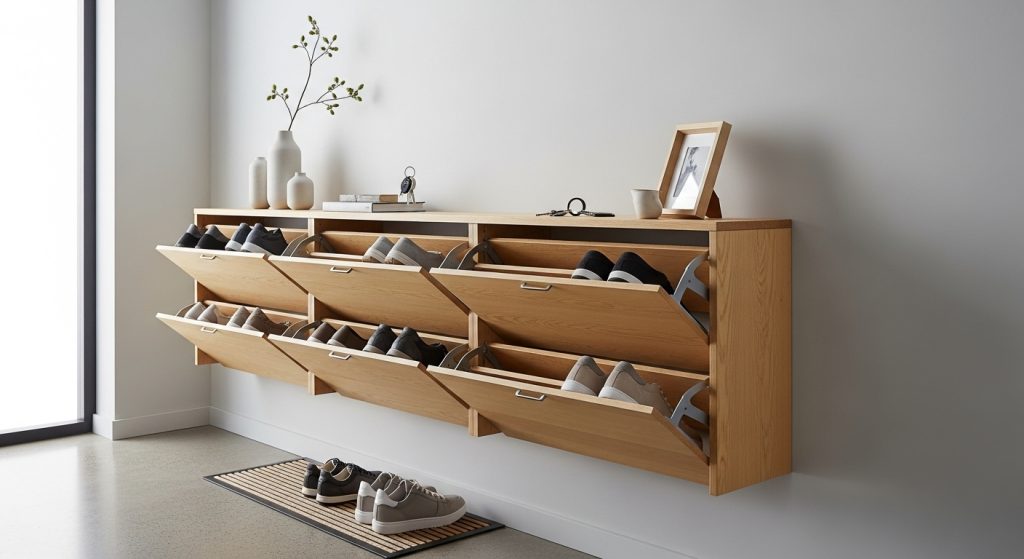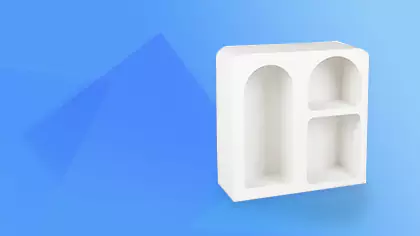These wall-mounted shoe cabinet ideas offer a definitive solution for conquering clutter and maximizing style in even the smallest entryways or hallways. Traditional shoe storage can consume valuable floor space, making tight areas feel cramped and difficult to navigate. By utilizing vertical wall space, these innovative “floating” cabinets provide ample storage while keeping the floor clear. This creates a powerful illusion of spaciousness and offers a clean, modern aesthetic.

This professional guide provides an expert overview of this smart storage category. It explores the different designs, benefits, installation considerations, and styling tips. It will empower you to choose and implement the perfect wall-mounted solution for a beautifully organized and space-efficient home.
What is the Core Principle Behind Wall-Mounted Shoe Storage?
The core principle behind wall-mounted shoe storage is vertical space optimization. Instead of occupying precious floor real estate, these solutions leverage the often-underutilized vertical plane of the wall. This approach frees up the floor, enhancing the sense of openness and making cleaning easier, while still providing dedicated, organized storage for footwear.
This “floating” concept is a cornerstone of modern, space-saving design. It creates a lighter, airier feel compared to traditional floor-standing furniture. By lifting storage off the ground, wall-mounted cabinets minimize visual bulk. This makes them an ideal choice for narrow hallways, tiny entryways, or any area where floor space is at a premium. This strategy is essential when seeking creative shoe storage ideas for tiny entryways. The trend towards minimalist and space-efficient living has significantly boosted the popularity of wall-mounted furniture solutions.
What Are the Key Benefits of Wall-Mounted Shoe Cabinets?
Wall-mounted shoe cabinets offer a compelling array of benefits that make them a superior choice for many homes, particularly those dealing with space constraints. These advantages go beyond simple storage; they impact the room’s feel, cleanliness, and overall design cohesion.
How Do They Maximize Floor Space?
The primary benefit is the maximization of floor space. By lifting the storage unit off the ground, the floor area underneath remains completely clear. This is invaluable in narrow hallways or small entryways where every square inch matters. It prevents the cabinet from becoming a physical obstacle. It also creates longer, uninterrupted sightlines along the floor, making the space feel significantly larger and less cluttered.
Why Do They Create a Cleaner, More Modern Look?
Wall-mounted cabinets inherently create a cleaner, more modern aesthetic. The floating effect feels light, airy, and contemporary. It aligns perfectly with minimalist and Scandinavian design principles. The lack of legs or a bulky base simplifies the visual landscape. This contributes to a more streamlined and sophisticated appearance compared to traditional floor-standing units. This clean look is a major factor in modern shoe cabinet organization design.
How Do They Make Cleaning Easier?
Keeping the floor clear makes cleaning significantly easier. There are no furniture legs to navigate around when vacuuming or mopping. Dust and dirt cannot accumulate underneath the cabinet. This simple practical advantage contributes to a cleaner and more hygienic entryway environment. This ease of maintenance is a highly valued feature in busy households.
What is the Advantage of Customizable Height?
Wall-mounted cabinets offer the advantage of customizable installation height. Unlike freestanding units with a fixed height, you can choose exactly where on the wall to mount the cabinet. This allows you to position it for optimal ergonomic access. You can also align it perfectly with other wall elements like light switches or dado rails, creating a more integrated and custom look.
What Are the Different Types of Wall-Mounted Shoe Cabinets?
Wall-mounted shoe cabinet ideas encompass a variety of designs, each offering different mechanisms, storage capacities, and aesthetic styles. Understanding these variations is key to selecting the perfect solution for your specific needs and space.
How Do Ultra-Slim Tilt-Out Cabinets Work?
Ultra-slim tilt-out cabinets are perhaps the most popular and ingenious wall-mounted design for shoes. These cabinets are exceptionally shallow, often only 6-8 inches deep. They feature compartments that tilt open like drawers, typically pivoting from the bottom or top edge. Inside, shoes are stored vertically or at a steep angle, often in single or double rows.
- Mechanism: The tilt-out mechanism allows for significant storage capacity within a minimal depth.
- Appearance: When closed, they present a sleek, flat facade, often resembling a simple wall panel or a shallow console. Many feature handleless, push-to-open doors for an even cleaner look.
- Best For: Extremely narrow hallways and minimalist aesthetics where concealed storage is desired.
What Are Wall-Mounted Cabinets with Doors?
These are essentially shallow cabinets with standard hinged or sliding doors that mount directly to the wall. Inside, they typically feature flat or slightly angled shelves designed for shoes.
- Storage: Offer versatile storage, often with adjustable shelf heights to accommodate different shoe types (flats, sneakers, heels).
- Appearance: Provide completely concealed storage. Door styles can vary from simple flat panels to designs with mirrors or decorative details. Mirrored doors can further enhance the sense of space.
- Depth: Generally slightly deeper than tilt-out models to accommodate shoes stored horizontally, but still much shallower than traditional cabinets.
Can You Use Wall-Mounted Open Shelves for Shoes?
Simple wall-mounted open shelves can also be used for shoe storage, offering a more casual and accessible approach.
- Design: Can range from simple floating shelves to modular cubby systems mounted on the wall.
- Pros: Very affordable, easy access to shoes, allows shoes themselves to be part of the display (if desired).
- Cons: Shoes are always visible (can look cluttered if not kept tidy), offers less protection from dust.
- Best For: Walk-in closets, mudrooms, or entryways where a very casual, organized look is acceptable. Best paired with a curated collection of frequently worn, visually appealing shoes.
What About Modular Wall-Mounted Systems?
Modular systems consist of individual wall-mounted units (cabinets, shelves, hooks) that can be combined and configured to create a custom storage solution. This allows you to tailor the storage precisely to your needs and available wall space. You could combine a tilt-out shoe cabinet module with a separate module for hanging coats or bags. This offers excellent flexibility but requires careful planning of the layout. The market for modular storage solutions is growing significantly.
How to Choose the Right Wall-Mounted Shoe Cabinet?
Choosing the right wall-mounted shoe cabinet involves a careful assessment of your storage requirements, the available wall space, the types of shoes you own, and your desired aesthetic. A systematic approach ensures you select a unit that is both functional and beautiful.
How Do You Accurately Assess Your Storage Needs?
Accurately assessing your needs is paramount. Don’t just estimate – actually count the pairs of shoes that need to be stored in the entryway. Consider whose shoes they are (adults vs. children) and what types (bulky sneakers vs. slim flats). Be realistic about how many pairs truly need to be readily accessible near the door. Overestimating needs can lead to choosing a unit that is unnecessarily large. Underestimating leads to overflow and clutter. A key part of how to organize shoes in small spaces without clutter is starting with an accurate inventory.
Why is Measuring Wall Space and Depth Crucial?
Precise measurement of your available wall space is non-negotiable.
- Width: Measure the horizontal space available, ensuring the cabinet won’t interfere with door swings, light switches, or traffic flow.
- Height: Consider the vertical space. Taller units maximize storage on a narrow footprint. Ensure the top of the cabinet doesn’t feel awkwardly high or low.
- Depth: This is the most critical measurement for narrow hallways. Measure how far the cabinet can project from the wall without becoming an obstacle. Remember that tilt-out drawers need clearance space in front to open fully. Standard hallway clearance guidelines recommend a minimum of 36 inches for comfortable passage.
How Does Shoe Type (Boots, Heels, Size) Impact Your Choice?
The types of shoes you primarily store will influence the best internal configuration.
- Boots: Most slim wall-mounted cabinets are not deep or tall enough for boots. Boots usually require a separate storage solution (like a bench or floor rack).
- High Heels: Some tilt-out designs or angled shelves are specifically designed to accommodate heels securely. Check the internal compartment height.
- Large Shoe Sizes / Bulky Sneakers: Require deeper or wider compartments. Always check the internal dimensions listed by the manufacturer, not just the external ones, to ensure your shoes will fit.
What Materials and Styles Complement Modern Interiors?
Wall-mounted shoe cabinets generally lend themselves well to modern and minimalist aesthetics. Common materials include:
- MDF with Lacquer or Laminate: Offers a smooth, seamless finish in colors like white, gray, or black. High-gloss finishes enhance the modern look.
- Wood Veneer: Provides the warmth of wood with a clean, modern profile. Light woods like oak or ash are popular choices.
- Metal: Powder-coated metal cabinets offer an industrial or ultra-minimalist look. They are very durable. Choose a material and finish that complements your existing entryway decor for a cohesive feel.
What is the Critical Importance of Secure Installation?
The secure installation of a wall-mounted shoe cabinet is paramount for safety and longevity. Unlike floor-standing furniture, these units rely entirely on their wall fixings to support their weight and the weight of the shoes inside. Improper installation can lead to the cabinet detaching from the wall, causing damage and potential injury.
Why Must You Locate Wall Studs?
Locating wall studs is the most critical step for a secure installation. Wall studs are the vertical wooden or metal beams that form the framework of your walls. Attaching the cabinet’s mounting hardware directly into these studs provides the strongest possible support. Relying solely on drywall anchors, especially for heavier cabinets, is risky.
- How to Find Studs: Use an electronic stud finder. These devices detect the change in density behind the drywall. Mark the edges of the studs clearly with a pencil. Most residential studs are spaced 16 or 24 inches apart on center.
What Are the Best Types of Wall Anchors (If Studs Aren’t Possible)?
If mounting directly into studs is not possible in the desired location, you must use high-quality drywall anchors specifically designed for heavy loads.
- Toggle Bolts: These feature spring-loaded “wings” that open up behind the drywall, providing a wide area of support. They offer excellent holding power.
- Screw-In Anchors (E-Z Ancor): These large, threaded anchors screw directly into drywall and offer better holding power than traditional plastic plugs.
- Molly Bolts: Metal anchors that expand behind the drywall as the screw is tightened. Crucially, always check the weight rating of the anchors and the cabinet itself. Use multiple anchor points distributed across the cabinet’s mounting bracket. When in doubt, consult a professional. The small cost of professional installation outweighs the risk of a cabinet falling.
How to Ensure the Cabinet is Perfectly Level?
Ensuring the cabinet is perfectly level during installation is important for both appearance and function. Use a spirit level placed on top of the cabinet as you mark the drilling holes and attach the mounting brackets. A cabinet that is not level will look awkward. Its doors or tilt-out mechanisms may also not operate smoothly.
Why is Professional Installation Often Recommended?
Professional installation is often recommended, especially for larger, heavier units or if you are uncomfortable with DIY tasks involving drilling into walls and locating studs. A professional handyman or installer has the tools and expertise to ensure the cabinet is mounted securely and correctly, providing peace of mind. This is particularly important in homes with older plaster walls or unusual construction.
How Do You Style and Organize a Wall-Mounted Shoe Cabinet?
Once securely installed, the final step is to style the cabinet (if it has a top surface) and organize the interior for maximum efficiency. The goal is a look that is both beautiful and highly functional, keeping your entryway clutter-free.
How to Style the Top Surface Minimally?
Many slim wall-mounted cabinets have a small top surface. Style this minimally to maintain the clean aesthetic.
- A Small Tray: Essential for keys and mail. Choose a sleek, low-profile design.
- One or Two Small Decor Items: A tiny potted succulent, a single framed photo, or a small candle. Avoid anything tall or bulky that could feel precarious.
- Leave it Empty: For the ultimate minimalist look, simply leave the top surface completely clear. The focus should remain on the cabinet’s clean lines and space-saving function.
What Are Smart Ways to Organize Shoes Inside?
Organize the interior to maximize capacity and make finding shoes easy.
- Assign Compartments: If possible, assign specific compartments or shelves to each family member.
- Use Shoe Stackers (If Space Allows): On flat shelves, shoe stackers can double the capacity for flatter shoes.
- Alternate Heel-Toe: On flat shelves, alternating pairs (one heel out, one toe out) can save space.
- Utilize Door Space: Some cabinets have small hooks or pockets on the inside of the doors for storing shoehorns or polish. These internal shoe storage ideas are key to making the system work effectively.
How to Integrate the Cabinet with Other Entryway Elements?
Integrate the cabinet visually by coordinating it with other entryway elements.
- Mirror or Art Above: Hang a mirror or piece of artwork above the cabinet to create a complete vignette and draw the eye upward. Ensure the scale is appropriate.
- Coordinate Colors: Match the cabinet color to the wall trim or pick up an accent color from a nearby rug.
- Lighting: Consider adding a small, stylish wall sconce above or beside the cabinet for functional lighting. This makes the cabinet feel like a deliberate part of the overall shoe cabinet organization design.
Conclusion
These wall-mounted shoe cabinet ideas offer a brilliant solution for anyone struggling with shoe clutter in a small entryway or hallway. By leveraging vertical space, these innovative designs provide ample storage while maintaining a clear floor and creating a sense of spaciousness. From ultra-slim tilt-out models to versatile modular systems, there is a wall-mounted option to suit every need and style. With secure installation and thoughtful organization, a floating shoe cabinet is more than just storage; it is a smart, stylish, and space-saving investment that brings order and elegance to your home’s threshold.











